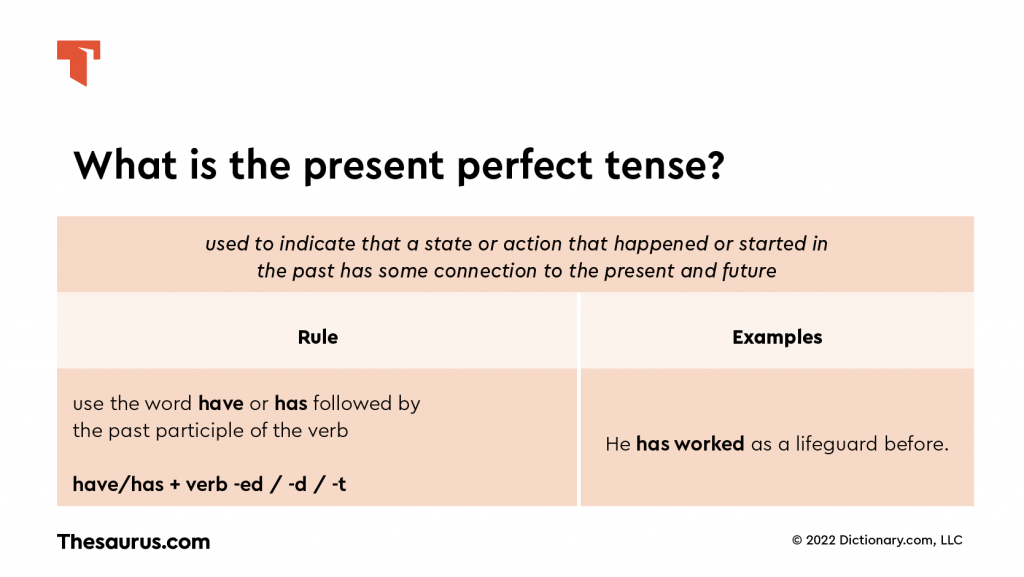Meet Sam. Here are some neat facts about Sam: Sam has performed in a rock band. Sam has met two American presidents. Sam’s mother has won the lottery twice. Not only are all these facts pretty cool, but they all use a special bit of grammar to connect the past with the present. All of these sentences use verbs in the present perfect tense. Let’s stop living in the past and take a moment to learn more about this interesting aspect of grammar right now. And enough about Sam!
What is present perfect tense?
We use verbs, to put it simply, to refer to actions or states of being. In English, we use a variety of different verb tenses in sentences. Generally speaking, the tense of a verb tells you about when in time something happened. Today, we will look at the present perfect tense. The present perfect tense may strike some as a bit of a misnomer, because it doesn’t seem to be referring to the present at all at first glance. You can see this in the following sentence that uses the present perfect tense:
- I have gone to the store three times today.
This sentence describes an action that happened in the past, as it says that I have made three trips to the store prior to the current moment when I am saying this sentence. At first look, this sentence seems to suggest that the present perfect tense does the same job as the simple past tense: I went to the store three times today. While simple past and present perfect can sometimes be effectively used interchangeably to get the same meanings (as with our inefficient trips to the store example), there can be slight but important differences in these two verb tenses. Look at the following two sentences:
- Simple past tense: She owned two Dalmatians for 10 years.
- Present perfect tense: She has owned two Dalmatians for 10 years.
Do you notice the difference? The first sentence states that she owned Dalmatians for a period of 10 years in the past but she doesn’t own them now. The action is finished and completed. The second sentence, however, implies that she still owns these dogs now. The action is still happening in the present. That is the key difference between these two similar verb tenses.
We have a simple explanation for all your questions about the simple past tense, right here.
When do you use present perfect tense?
One of the main reasons we use the present perfect tense is to indicate that a state or action that happened or started in the past has some connection to the present and future. Typically, we use the present perfect tense to indicate something happened in the past but continues to occur. For example:
- I have waited for two hours. (I started waiting two hours ago and I am still waiting now.)
- They have lived here all their lives. (They started living here a long time ago and still live here now.)
The present perfect tense can also connect present events to those that happened in the past. For example, the sentence Josh is acting as our tour guide through Boston because he has been here before says that Josh traveled to Boston sometime in the past. This sentence also implies that we are all in Boston right now because it also uses the present continuous tense.
Often, we are faced with the tough decision of whether we should use the present perfect tense or the simple past tense in a sentence. If a past action has no connection to the present, it may be more appropriate to use the simple past tense:
- I have lost my wallet! (You recently lost your wallet in the past and you really want to find it right now.)
- I lost my wallet. (You lost your wallet in the past but it has no impact on the current time. You either found it or it remained lost forever and you gave up looking for it.)
That said, in everyday speech, both utterances do effectively mean the same thing. Thanks, grammar.
Notably, we don’t use the present perfect tense when we talk about specific times or time periods that began and completely ended in the past:
❌ Incorrect: I have cleaned the house at 9 am this morning.
✅ Correct: I cleaned the house at 9 am this morning.
❌ Incorrect: He has studied Spanish last year.
✅ Correct: He studied Spanish last year.
How to form present perfect tense
In order to form the present perfect tense, we use the word have or has followed by the past participle of the verb. For regular verbs, the past participle is a form of the verb that ends in -ed, -d, or -t. For example, the past participle of cook is cooked and so the present perfect tense would be have/has cooked. Some verbs use a –t variant in the past participle and end in a –t rather than -ed. For example, the past participle of bend is bent and the past participle of sleep is slept.
Has and have make a lot of difference in English grammar. See what else they have going on here.
Keep in mind, though, that there are many irregular verbs that don’t follow this general rule. Here are the past participles of just a few irregular verbs:
- go → gone
- fly → flown
- catch → caught
- be → been
- rise → risen
- ride → ridden
- break → broken
We use the word have in the present perfect tense except when the subject is in the third person singular, in which case we use the word has. For example:
- I have worked as a lifeguard before.
- The cats have eaten twice already.
- She has given me lots of good advice.
- I think Brian has seen my house once before.
When using the present perfect tense, we can also shorten our sentences with contractions:
- I’ve worked as a lifeguard before.
- They’ve eaten twice already.
- She’s given me lots of good advice.
- I think he’s seen my house once before.
How to make present perfect tense negative
To make the present perfect tense negative, all you need to do is put the word not after have/has. The contractions haven’t and hasn’t can also be used. Here are examples of sentences that use the present perfect tense in the negative:
- I have not talked to Ashley yet.
- I haven’t talked to Ashley yet.
- Vince has not finished his sandwich.
- Vince hasn’t finished his sandwich.
- We haven’t met the new neighbor.
- We have not met the new neighbor.
- Our teacher has not graded our exams yet.
- Our teacher hasn’t graded our exams yet.
What else is perfect? Your writing
You won’t mistake your verb tenses again when you check your writing on Thesaurus.com’s Grammar Coach™. This tool uses machine learning technology uniquely designed to catch grammar and spelling errors. Its Synonym Swap will find the best nouns, adjectives, and more to help say what you really mean, guiding you toward clearer, stronger, writing.
Whether you’re writing about the past, present, or future, start writing smarter today!
















